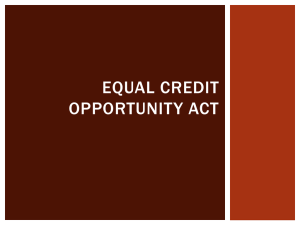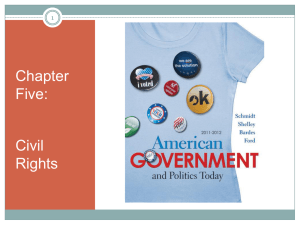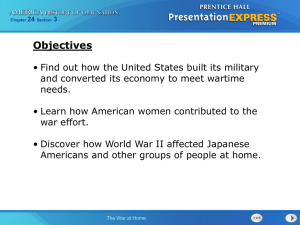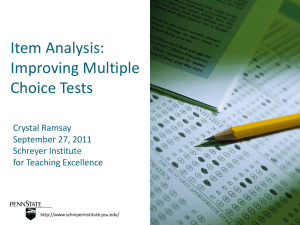Strategic Pricing AEM 4160
advertisement
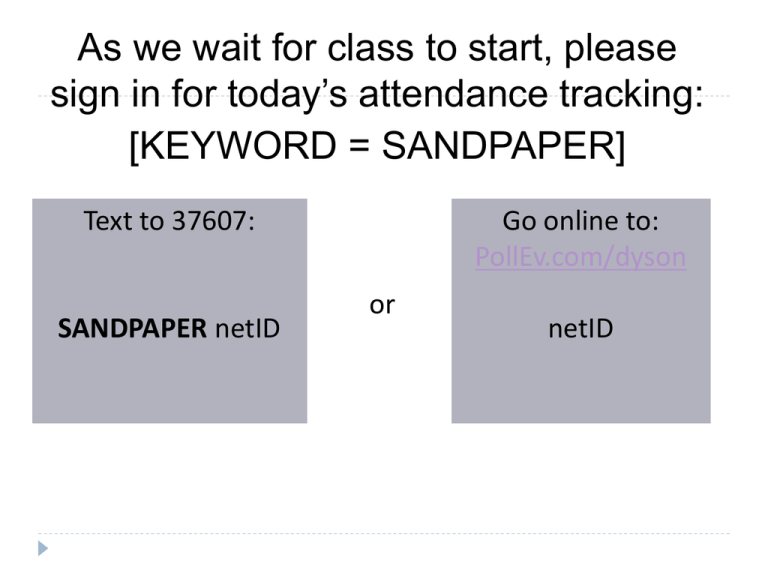
As we wait for class to start, please sign in for today’s attendance tracking: [KEYWORD = SANDPAPER] Text to 37607: SANDPAPER netID Go online to: PollEv.com/dyson or netID Lecture 4: Price Discrimination AEM 4160: Strategic Pricing Prof. Jura Liaukonyte 2 Price Discrimination Examples Industry Paper towels, soft drinks in supermarket Discrimination Mass discount Business class Economy class US. 10$ per pack China 1$ per pack Microsoft office $750 buy Microsoft office’s each component individually $2060 Air fares Marlboro sold in different countries Software Price Discrimination Definition Oxford Dictionary the action of selling the same product at different prices to different buyers, in order to maximize sales and profits Suppliers try to steal consumer surplus by pricing as close as possible to their willingness to pay Conditions Price Discrimination Definition Oxford Dictionary Conditions the action of selling the same product at different prices to different buyers, in order to maximize sales and profits Suppliers try to steal consumer surplus by pricing as close as possible to their willingness to pay Four Conditions 1. Monopoly Power 2. Identifiable submarkets 3. Different price elasticities of demand 4. Prevention of arbitrage Arbitrage Definition: Buy a good and sell it for a higher price to someone/somewhere else 3 Types of Price Discrimination First Degree Charge different price for every unit sold Most effective – capture all Consumer Surplus Second Degree Provide choices and let consumers self-select different prices depending on volume and usage Third Degree Easily segmented market E.g: Geography Senior Citizen First Degree PRICE DISCRIMINATION First Degree Price Discrimination P The first unit has the highest price P MC P1 D Q1 The price drops for every additional unit based on each buyers willingness to pay MC P1 P2 P3 Q D Q1 Q2 Q3 Q First Degree Price Discrimination P P1 P2 P3 Consumers pay exactly what they are willing to pay Consumer Surplus = WTP-P = 0 Producer Surplus = P-MC │P=WTP Consumer Surplus in perfect competition = Additional producer surplus in case of first degree price discrimination MC +PS P4 D Q1 Q2Q3 Q4 Q Slide 11 Price Discrimination First Degree Price Discrimination: Summary Charge a separate price to each customer: the maximum or reservation price they are willing to pay. Additional Profit From Perfect First-Degree Price Discrimination Question Why would a producer have difficulty in achieving firstdegree price discrimination? Slide 12 Additional Profit From Perfect First-Degree Price Discrimination Question Why would a producer have difficulty in achieving firstdegree price discrimination? Answer 1) Too many customers (impractical) 2) Could not estimate the reservation price for each customer Slide 13 Slide 14 Price Discrimination First Degree Price Discrimination Other examples of imperfect price discrimination where the seller has the ability to segregate the market to some extent and charge different prices for the same product: Lawyers, doctors, accountants Car salesperson (15% profit margin) Colleges and universities Example: Credit Card Industry How The Industry Works Credit agencies keep track of consumer credit history. Banks originate credit lines and determine terms. Banks lend consumers lines of credit Fixed amount of money based primarily on income and FICO score Terms, including interest rates, are determined based on FICO score Credit Agencies Agencies Experian, TransUnion, Equifax Collect Data Social Security Number Risk Factor Payment History Account History Debt-to-Credit Ratio Age of Account Average Account Coverage Debt Available Credit Accounts 30 days, 60 days, 90 days late Understanding the FICO Score First Degree Pricing Using FICO Score FICO scores provide a snapshot of the consumer's credit worthiness, and companies price on an individual basis Less risky consumers are worth more in the long run More responsible spending, payments on time High risk consumers are less desirable, but can be highly profitable. Higher risk means higher APRs, worse terms for consumer First Degree Price Discrimination However, first-degree price discrimination has found a place on the Internet in the form of reverse auctions. In a reverse auction, a customer names the price he is willing to pay, and the seller decides whether or not to offer him that price. (Customers are restricted from bidding on the same item multiple times within a certain amount of time, eliminating their ability to start out low and increase the bid until it is accepted). Priceline is the most commonly cited example of a reverse auction. http://www.priceline.com/ Google’s IPO was the first hybrid-Dutch Auction First-degree price discrimination Suppose that you own five antique cars Market research indicates that there are collectors of different types keenest is willing to pay $10,000 for a car, second keenest $8,000, third keenest $6,000, fourth keenest $4,000, fifth keenest $2,000 Contrast with linear pricing: all cars sold at the same price 22 sell the first car at $10,000 sell the second car at $8,000 sell the third car to at $6,000 and so on total revenue $30,000 set a price of $6,000 sell three cars total revenue $18,000 Informational Requirements Are 1. 2. 3. 4. four criteria satisfied? Monopoly Power Identifiable submarkets Different price elasticities of demand Prevention of arbitrage Do you think first degree price discrimination is common? What are the informational requirements for the seller? 24 Conclusions The information requirements for first degree price discrimination appear to be insurmountable but not in particular cases tax accountants, doctors, students applying to private universities First-degree price discrimination is highly profitable but requires detailed information ability to avoid arbitrage Leads to the efficient choice of output: since price equals marginal revenue and MR = MC no value-creating exchanges are missed SECOND Degree PRICE DISCRIMINATION 26 Second-degree price discrimination What if the seller cannot distinguish between buyers? perhaps they differ in income (unobservable) Then the type of price discrimination just discussed is impossible High-income buyer will pretend to be a low-income buyer to avoid the high entry price to pay the smaller total charge Second-degree price discrimination Firms typically offer a list of different prices to consumers allowing the consumers to self-select. Also called VERSIONING pricing strategy: companies sell variations of a product or service at different prices to different groups of customers. Create versions of a product to appeal to different types of buyers. Customers then choose the version that best meets their needs. Distribute a physically similar product under different brand names, E.g. GAP, Old Navy, Banana Republic Filene’s Basement, TJMaxx, Marshalls Second-Degree Price Discrimination Example Self Selection HD vs. SD – Value of high definition Movies Link TurboTax Link Options: Individual with bigger need Health Clubs Off peak hours discount: busy individual vs. student Getty Images Resolution – Professional vs Casual Buy Bulk at Sam’s Self select price per unit based on quantity Second-Degree Price Discrimination In some markets, consumers purchase many units of a good over time Demand declines with increased consumption Price Discrimination: Charge different prices to increase volume Charge different prices per unit for different quantities of the same good Quantity Discounts Block Pricing: Charge different price for blocks of a good e.g. Electric Power 30 Second-degree price discrimination Essence of second-degree price discrimination It is “like” first-degree price discrimination the seller knows that there are buyers of different types but the seller is not able to identify the different types Seller has to compromise Design a pricing scheme that makes buyers reveal their true types self-select the quantity/price package designed for them 31 Second-degree price discrimination Will the monopolist always want to supply both types of consumer? There are cases where it is better to supply only highdemand types high-class restaurants golf and country clubs Second-degree price discrimination principles Page 32 Induce customers to select into high and low price groups themselves. Key constraint: you can’t make the inexpensive version too attractive to those willing to pay more. If there aren’t many customers in the low-valuation group, you may want to ignore this group, since selling to it forces you to lower the price to the high valuation group. More types of second degree price discrimination Example Page 33 Self Selection Intertemporal High Valuation users are less patient Quantity Discounts High valuation consumers pay high price for higher volume Multiple two-part tariff Example: cell phone plans with monthly and per minute fees – Separate between high and low volume users Page 34 Takeaways Firms would prefer to use perfect (aka first-degree) price discrimination, but this may be impossible. Second-degree PD induces customers to sort themselves into groups. Recall the no arbitrage constraint—consumers can’t resell to others. Price discrimination and other advanced pricing strategies are powerful tools; you now have the economic models to understand them. 35 Feasibility of price discrimination Two problems confront a firm wishing to price discriminate 1 identification: the firm is able to identify demands of different types of consumer or in separate markets easier in some markets than others: e.g tax consultants, doctors 2 arbitrage: prevent consumers who are charged a low price from reselling to consumers who are charged a high price prevent re-importation of prescription drugs to the United States The firm then must choose the type of price discrimination first-degree or personalized pricing second-degree or menu pricing third-degree or group pricing Example: Tablet Industry Intertemporal pricing People value things differently depending on the point in time they will receive it Value now > Value later (Hyperbolic Discounting) eReader and Tablet companies exploit this discrepancy by marking up their product upon introduction Capture the consumer surplus of early-adopters They later lower their prices to reflect the reduction in value that occurs when the product leaves the initial market entry stage and more consumers begin to enter the market Intertemporal Pricing: eReaders Intertemporal Pricing: eReaders Intertemporal Pricing: eReaders Example: Airline Industry 2nd Degree Price Discrimination Price Dispersion Variation in prices for the same item Versioning Variations of a product or service at different prices to different groups of customers First Class vs. Coach seating Price Dispersion The expected difference in fares paid is 36% Airlines likely to have 20 or more different fares on one given flight Example: Ski Industry Product Differentiation A form of second degree price discrimination Provide customers with many options and they choose what to purchase Ski resort industry offers a variety of products and services in order to: Meet consumer needs Maximize revenue Maximize producer surplus Increase customer base Product Differentiation Ski Pass Differentiation Type of ski pass Full day pass Half day pass Night pass Length of ski time One day pass Weekend pass Week pass Season pass Ski Lift Ticket Prices: Bristol Mountain Adult Prices Price (in dollars) All Day and Night (Opening10pm) 8-hours (starting anytime) 57 4-hours (starting anytime) 51 Twilight (4pm-10pm) 36 Evening (7pm-10pm) 30 54 Variations in Ski Pass Options As the number of days purchased at one time increases, the price per day of the ticket decreases Resorts do this to encourage customers to buy more days worth of tickets

